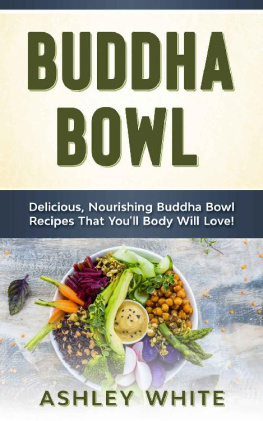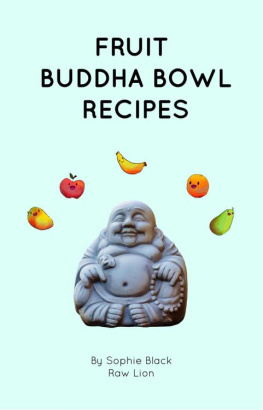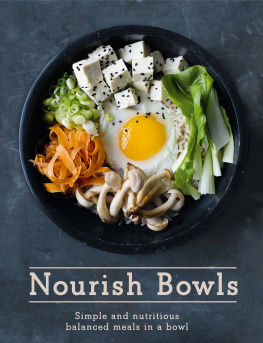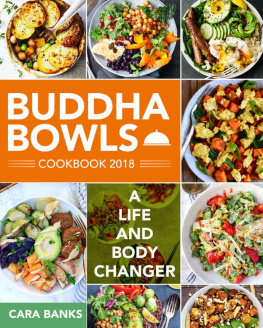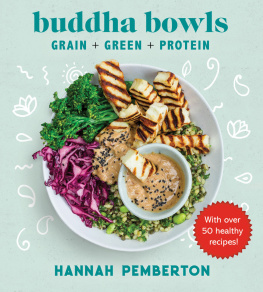Buddha Bowl
Delicious, Nourishing Buddha Bowl Recipes Your Body Will Love!
1st Edition
By Ashley White
Copyright 2018 by Ashley White. All rights reserved.
This document is geared towards providing exact and reliable information in regards to the topic and issue covered. The publication is sold with the idea that the publisher is not required to render accounting, officially permitted, or otherwise, qualified services. If advice is necessary, legal or professional, a practiced individual in the profession should be ordered.
- From a Declaration of Principles which was accepted and approved equally by a Committee of the American Bar Association and a Committee of Publishers and Associations.
In no way is it legal to reproduce, duplicate, or transmit any part of this document in either electronic means or in printed format. Recording of this publication is strictly prohibited and any storage of this document is not allowed unless with written permission from the publisher. All rights reserved.
The information provided herein is stated to be truthful and consistent, in that any liability, in terms of inattention or otherwise, by any usage or abuse of any policies, processes, or directions contained within is the solitary and utter responsibility of the recipient reader. Under no circumstances will any legal responsibility or blame be held against the publisher for any reparation, damages, or monetary loss due to the information herein, either directly or indirectly.
Respective authors own all copyrights not held by the publisher.
The information herein is offered for informational purposes solely, and is universal as so. The presentation of the information is without contract or any type of guarantee assurance.
Table of Contents
Introduction
What on Earth is a Buddha bowl?
Now, whether you are someone who came across a couple of pictures of them on Instagram or Pinterest, or someone who has already tried whipping up a bowlful at home, this cookbook is dedicated to you.

In fact, this book is chock full of Buddha bowl recipes and guidelines that will turn you from a curious cook to a seasoned Buddha bowl guru. For instance, you will not just learn about the evolution of the Buddha bowl, but also how to set up a kitchen dedicated to making it. Moreover, you will learn a wide array of Buddha bowl recipes for all meals during the day breakfast, hearty and light lunches, after-workout protein-packed versions, and even the ones with meat for the omnivores out there.
Imagine waking up to a delectable Fruity Banana Acai Breakfast Bowl , and then having a savory Barbeque Style Black Bean Buddha Bowl with Vegan Ranch Sauce for lunch before a Sprouted Lentil and Wheat Berries Bowl with Mustard Maple Sauce for a light, guilt-free dinner. Tasty, easy, and nutritious, indeed! These and so much more are in store for you in the pages of this book.
Now, it might sound like some crazy new millennial trend, but there is much more to Buddha bowls than meets the eye. Buddha bowls are not just colorful, Instagrammable, healthy, and tasty meals, for they also offer comfort, satisfaction, self-confidence, and nourishment.
So, I gladly invite you to turn to Chapter 1 and start falling in love with Buddha bowls! You, your taste buds, and tummy will certainly not regret it!
Chapter 1 Say Hello to the Buddha Bowl!
Nowadays, more and more people are looking for ways to improve their diet. Today we're becoming more aware of the value of good health. As diet trends come and go, one thing remains certain, and it is the fact that we should eat a variety of whole grains, fruits and veggies every day. By doing so, the body is well-nourished with all the different vitamins and minerals it needs.
Making sure that you have your daily servings of carrots, tomatoes, leafy greens, squash, chickpeas, herbs, and other vibrant and nutritious plant-based food in your diet is no easy feat. There seems to be so many things a person should do to enjoy vegetables, from having to worry about what vegetarian recipe to follow to purchasing different ingredients, chopping them up, and prepping them in one s own kitchen. If we have to worry about all these, it is no wonder that many of us would resort to fast foods and extremely unhealthy but easy to prepare meals at home.
The good news, however, is that you do not have to make veggie meal prep so hard. In fact, there is one way of preparing veggie meals that will make the goal of maintaining a healthy diet so much easier to achieve. This is by learning how to make Buddha Bowls. Also referred to nowadays as the hippie bowl, the Buddha bowl is a dish that is made up of a wide variety of wholefood ingredients, artfully assembled to look appetizing, and served with a delicious sauce to make the vegetables in it highly enjoyable. The best Buddha bowl recipes are the ones that are high in fiber, lean protein, healthy carbs and fat, and of course various vitamins, minerals, antioxidants, and other important nutrients.
The best thing about Buddha bowls is they are super easy to prepare. Often, you will simply need a recipe to guide you, along with some everyday kitchen equipment such as food processors for quick and easy chopping, a skillet for searing and stir-fries, and an oven for crisp tender roasted veggies. Naturally, you will need a good old bowl from which you will enjoy your freshly prepared veggies.
The Buddha Bowl that many of us are all too familiar now was actually inspired by a traditional vegetarian dish known as the Buddha s Delight ( luohan zhai , lo hon jai , or lo han jai in Chinese), which originated from the Buddhist cuisine in China. It goes without saying that those who came up with it and enjoyed it first before it entered pop cuisine are the Buddhist monks.
The Buddha s Delight is so ingrained into the Buddhist Chinese culture that Chinese households would traditionally prepare them using the finest and rarest ingredients and serve them on the first day of the Chinese New Year. The reason for this is to somehow jumpstart the vegetarian diet, which should be adhered to strictly for five consecutive days of the new year. The Chinese believe that the vegetarian diet is one way to purify oneself.
According to the Buddhist cuisine, the traditional Buddha Bowl should have a minimum of 10 (obviously vegetarian) ingredients. The more variety and color, the better, of course. In fact, some chefs would even go as far as combining 35 ingredients in a Buddha Bowl. Aside from the fact that many ingredients make the Buddha Bowl more appealing with its variety in textures, shapes, and colors, this also enables the person enjoying it to take in the wide variety of nutrients that his or her body sorely needs.
The most common ingredients found in a traditional Buddha Bowl are those abundant in Chinese agriculture. Napa cabbage, torn or shredded, is a stable leafy green, for instance. Steamed snow peas and water chestnuts are also incorporated into the bowl, followed by bean threads (otherwise known as cellophane noodles) soaked in hot water. Thinly sliced crunchy carrots, chewy black mushrooms and tender bamboo shoots also add flavor, color, and texture the dish, often accompanied by edible fungus, such as bamboo fungus, fat choy, and black fungus (or wood ear ). Crushed peanuts, fried or braised wheat gluten, lotus seeds, and fried tofu are then added on top of the dish.
Without a doubt, some of these ingredients may sound quite exotic to many of those who did not grow up in China, but rest assured you can create so many Buddha bowls with ingredients that are more readily available in your market, wherever you may be. For instance, many Buddha bowl recipes call for such leafy greens as bok choy (or pak choi), a Chinese cabbage that you can find in almost any veggies section in the grocery store. Cauliflower, celery, potatoes, corn kernels and baby corn, straw mushrooms, oyster mushrooms, dried oysters, and bean sprouts are also conventional Buddha bowl ingredients. Moreover, those who are not completely vegetarian in that they are okay with eating eggs and seafood can incorporate hardboiled quail eggs and pan-seared shrimp, scallops, and shredded fish into their Buddha bowls.
Next page
